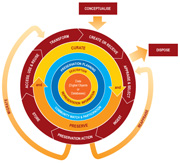News Releases | November 20, 2009
Share ThisFOR IMMEDIATE RELEASE
IMLS Press Contacts
202-653-4632
Jeannine Mjoseth, jmjoseth@imls.gov
Mamie Bittner, mbittner@imls.gov
 |
|
Model of the digital curation lifecycle. Click here for details.
|
Washington, DC—Scientists, researchers, and scholars across the world generate vast amounts of digital data, but the scientific record and the documentary heritage created in digital form are at risk -- from technology obsolescence, from the fragility of digital media, and from the lack of baseline practices for managing and preserving digital data. The University of North Carolina Chapel Hill (UNC-CH) School of Information and Library Science, working with the Institute of Museum and Library Services (IMLS) and partners in the United Kingdom (U.K.), are collaborating on the Closing the Digital Curation Gap (CDCG) project to establish baseline practices for the storage, maintenance, and preservation of digital data to help ensure their enhancement and continuing long-term use. Because digital curation, or the management and preservation of digital data over the full life cycle, is of strategic importance to the library and archives fields, IMLS is funding the project through a cooperative agreement with UNC-CH. U.K. partners include the Joint Information Systems Committee (JISC), which supports innovation in digital technologies in U.K. colleges and universities, and its funded entities, the Strategic Content Alliance (SCA) and the Digital Curation Centre (DCC).
Well-curated data can be made accessible for a variety of audiences. For example, the data gathered by the Sloan Digital Sky Survey (www.sdss.org) at the Apache Point Observatory in New Mexico is available to professional astronomers worldwide as well as to schoolchildren, teachers, and citizen scientists through its Galaxy Zoo project. Galaxy Zoo, now in its second version, invites citizen scientists to assist in classifying over a million galaxies (www.galaxyzoo.org). With good preservation techniques, this data will be available into the future to provide documentation of the sky as it currently appears.
Data and information science researchers have already developed many viable applications, models, strategies, and standards for the long term care of digital objects. This project will help bridge a significant gap between the progress of digital curation research and development and the professional practices of archivists, librarians, and museum curators. Project partners will develop guidelines for digital curation practices, especially for staff in small to medium-sized cultural heritage institutions where digital assets are most at risk. Larger institutions will also benefit. To develop baseline practices, a working group will establish and support a network of digital curation practitioners, researchers, and educators through face-to-face meetings, web-based communication, and other communication tools. Project staff will also use surveys, interviews, and case studies to develop a plan for ongoing development of digital curation frameworks, guidance, and best practices. The team will also promote roles that various organizations can play and identify future opportunities for collaboration.
As part of this project, the Digital Curation Manual, which is maintained by the DCC, will be updated and expanded www.dcc.ac.uk/resource/curation-manual/chapters and the Digital Curation Exchange web portal will receive support (http://digitalcurationexchange.org). Through these efforts, the CDCG project will lay the foundation that will inform future training, education, and practice. The project’s research, publications, practical tool integration, and outreach and training efforts will be of value to organizations charged with maintaining digital assets over the long term.
The CDGP will be based upon findings from a number of efforts supported by IMLS, the U.K. and the U.S. National Science Foundation (NSF). U.K. funding for digital curation has focused largely on developing U.K.-wide digital repositories, especially in the sciences, and on training data curators, working in disciplines served by the particular repositories. IMLS funding has focused on research and development projects that build the capacity of libraries to preserve and manage digital content, and on building the capacity of graduate schools of library and information science to offer educational programs that prepare librarians and archivists for these new roles. The NSF, through its DataNet program, is supporting large-scale collaborative projects that provide reliable digital preservation, access, integration, and analysis capabilities for science data over a decades-long timeline, and contribute to an interoperable data preservation and access network.
About the Institute of Museum and Library Services
The Institute of Museum and Library Services is the primary source of federal support for the nation's 123,000 libraries and 17,500 museums. The Institute's mission is to create strong libraries and museums that connect people to information and ideas. The Institute works at the national level and in coordination with state and local organizations to sustain heritage, culture, and knowledge; enhance learning and innovation; and support professional development. To learn more about the Institute, please visit www.imls.gov.
